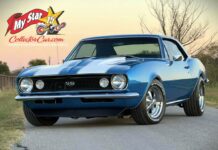You hear the term survivor thrown around recklessly at car shows–but few vehicles meet every requirement for survivor.
Time is the biggest factor because parts wear out and paint fades over a few decades– unless you park a new car in a climate-controlled, vacuum-sealed environment.
That rarely happens, so most car guys are faced with preserving what’s left after an old car or truck does real time in the real world.
Jerry Sutherland

Lee Penman faced the real world when he bought a 1964 Chevy Biscayne station wagon. This was a real-world survivor because it was a bush car with no engine or transmission, but Lee said, “It was sheltered by trees” so there was something left to save. He didn’t know much about the car’s history, but the dealer sticker told him it was sold at Red Deer Motors.

The previous owner had it at his shop where it sat for awhile after being rescued from the bush. Lee spotted it in the shop and made an offer because he had a history with ’64 Chevys. He’d owned a ’64 Impala and he’d used it as his “courting car” years ago, so this wagon reminded him of his past.

The Biscayne wagon was in surprisingly good shape after many years in the wild, so Lee mapped out a plan to save as much as he could. The paint was decent, but he did have some rust to address in the quarter panel/rear wheel well area—plus the hood was in bad shape.

The key to success was a blending of old and new paint, so more of the factory finish could be saved. The new metal was necessary because that’s how many real survivor cars end up in the real world.

Lee had a replacement 283 and Powerglide sourced for the Biscayne because he wanted to stay true to its history. In his world, a new crate 350 would have been a betrayal of the wagon’s past.

The car’s condition made the job easier because all the factory glass was still there, so Lee only had to pop for a new windshield. This is a Chevy, so the replacement cost was minimal. Lee said the glass is so extensive it’s like driving a greenhouse when he’s behind the wheel.

The interior was in good shape because Lee only had to do the front seat—the back seat upholstery came straight from the factory in ’64 when this car was built. The rest of the car’s interior is stock too, so the survivor status theme remained inside the car.

Lee built a custom dual-snorkel air cleaner because he wanted the two-barrel carburetor to breathe better. The rest of the under-hood area is stock 1964 Chevy.

This wagon is pure driver quality. The paint shows its years, but that’s the key to a survivor car. Lee did his best to minimize the new paint on the car because the more you replace, the less of the original car remains.

The car shows 129,000 miles—that’s likely true because the car sat for so many years. Lee does casual driving in the Biscayne wagon, so he only hits a few car shows per year. He likes to run it at 55-60 miles per hour because the steering box is a little vague and the car “wanders a bit”—in his words.
The goal was to try and preserve a real-world survivor—call it a job well done.
Jerry Sutherland
By: Jerry Sutherland
Jerry Sutherland is a veteran automotive writer with a primary focus on the collector car hobby. His work has been published in many outlets and publications, including the National Post, Calgary Herald, Edmonton Journal, Ottawa Citizen, Montreal Gazette, Saskatoon StarPhoenix, Regina Leader-Post, Vancouver Sun and The Truth About Cars. He is also a regular contributor to Auto Roundup Publications.
- CLICK HERE TO SIGN UP FOR THE NEWSLETTER
- CLICK HERE to Like us on Facebook
- CLICK HERE to Follow us on Twitter
- CLICK HERE to Follow us on Pinterest
Please re-post this if you like this article.
























































